1. Background
First of all, with the continuous development of the blockchain industry, various forms of chains have emerged, such as Layer1, Layer2, Layer3, sidechains, Rollups, etc. There are both homogenous and heterogeneous chains, and each blockchain is divided into many different protocols.
These different blockchains and protocols have fragmented the world of blockchain into isolated information islands, with a large number of encrypted assets distributed across these different chains and protocols, which undoubtedly reduces the utilization efficiency of funds.
The emergence of cross-chain bridges can build bridges between these different chains, allowing assets from one chain to be bridged to other blockchains.
For example, the introduction of the Base cross-chain bridge, a Layer2 network launched by Coinbase, can bridge encrypted assets from other chains to the Base network. Users can enjoy some early dividends of the Base chain. At the same time, through the cross-chain bridge, assets on the Base chain can also be bridged to other blockchains.
- Why is NFT the best medium to realize the theory that ‘1000 fans can support a KOL’?
- Analysis of the current status of ERC-4337 accounts on the blockchain and what new opportunities exist
- Can the vision of wealth redistribution through UBI of Worldcoin be realized through the Meme? Interpreting Trait Sniper’s overnight explosion in popularity.
The emergence of cross-chain bridges greatly improves the efficiency of fund utilization. 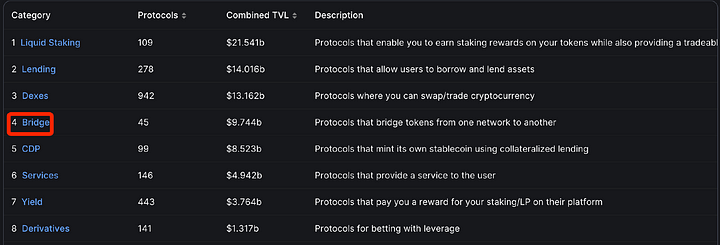
According to defillama’s data, the total value locked (TVL) of cross-chain bridges ranks fourth in the current DeFi landscape, reaching a volume of 9.7 billion US dollars, second only to the Dex track.
In addition, in the cross-chain bridge track, there are generally issues such as low security, high fees, and slow cross-chain speeds. Stargate appears in such a background.
2. Overview of the Stargate Protocol
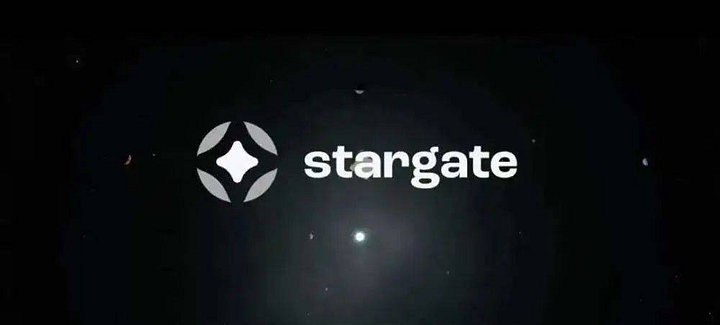
Stargate Finance is a multi-chain cross-chain bridge protocol based on LayerZero. It was created by LayerZero Labs in March 2022 and is also the first DApp based on the LayerZero protocol. It is a protocol that enables asset transfers between multiple blockchains.
Stargate aims to simplify the process of transferring assets from one blockchain to another, eliminating the cumbersome steps of locking, minting, burning, and redeeming, to achieve the convenience of completing transfers in a single transaction.
Since Stargate is a cross-chain protocol built on LayerZero, it is necessary to start with LayerZero when talking about Stargate.
What is LayerZero
LayerZero is an omnichain interoperability protocol. LayerZero has built a new ultra-light node mode, providing a secure and reliable infrastructure for various cross-chain protocols. 
In theory, LayerZero can achieve message transmission on any chain that supports smart contracts. For example, if a user sends a message on Chain A, this message can be transmitted to Chain B, allowing the smart contracts on Chain B to perform corresponding operations. LayerZero enables information communication between different chains, including the transfer of assets between different chains.
LayerZero is not a public chain or an application ecosystem, but a more underlying protocol. The positioning of LayerZero is similar to the TCP protocol in the transport layer of the Internet, on which many different DApps can be built.
How does LayerZero achieve full-chain interoperability
We first understand the differences between full nodes, light nodes, and ultra-light nodes.
- Full nodes: Nodes that synchronize all blockchain data, storing both block headers and specific transaction information.
- Light nodes: Only store a small portion of blockchain data, such as block headers and other information, without storing specific transaction information within the blocks.
- Ultra-light nodes: Instead of keeping all block headers, they stream block headers on demand through oracles, achieving efficient synchronization with external entities to reach the desired state.
LayerZero achieves full-chain interoperability by deploying an endpoint (client) on each chain. The endpoint runs an ultra-light node (ULN) and then uses an oracle to stream block headers containing cross-chain information (rather than sequentially transmitting all block headers to reduce costs). The relayer is then used to transmit transaction proofs (proof information), and both parties verify each other to ensure the correctness of cross-chain information.
The following diagram shows the process of a user application (UA) on Chain A sending a message to a user application on Chain B via LayerZero. 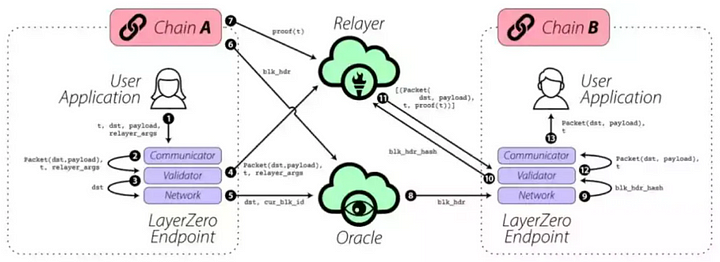
The full-chain interoperability of LayerZero is achieved through the combined action of these three core components: endpoint, oracle, and relayer.
Based on this full-chain interoperability of LayerZero, many business scenarios that were previously difficult to implement can be realized, such as full-chain cross-chain bridges, cross-chain transactions, and cross-chain lending. Stargate is the official cross-chain bridge launched by LayerZero, which is also the first DApp based on the LayerZero protocol. The LayerZero team refers to it as the first solution to the “trilemma of bridging”.
III. How does Stargate achieve cross-chain interoperability?
It is well known that there is an “impossible triangle” theory in public chains, referring to the decentralization level, security, and scalability. A public chain can only satisfy two of these aspects at most.
For example, for Bitcoin, its decentralization level and security are relatively high, but its scalability is relatively poor. For many public chains, although scalability and security have improved, they have sacrificed decentralization.
The “impossible triangle” dilemma in the field of public chains can be solved through modular public chains.
Similarly, in the field of cross-chain, there is also an “impossible triangle” theory, which includes:
- Instant Guaranteed Finality;
- Unified Liquidity;
- Native Assets.
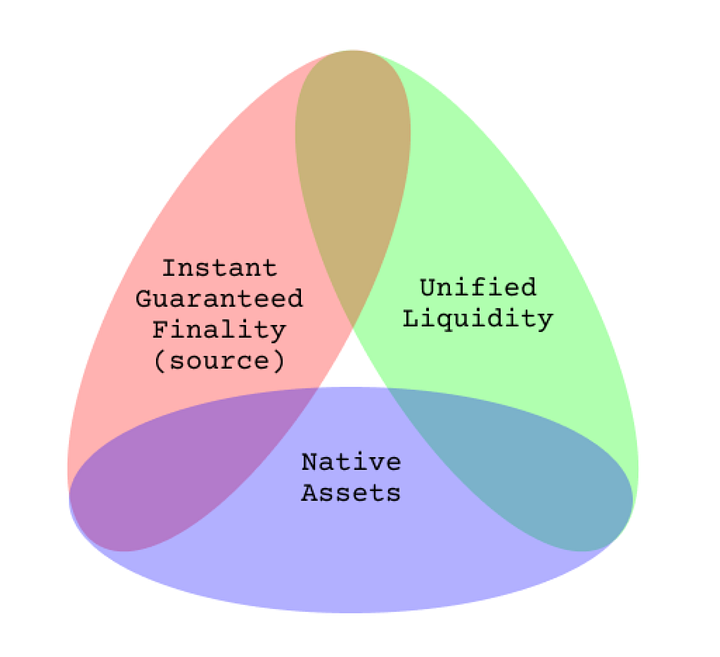 In most cross-chain bridges, it is only possible to achieve one or two of these three points at most, and not all three at the same time.
In most cross-chain bridges, it is only possible to achieve one or two of these three points at most, and not all three at the same time.
However, the Stargate cross-chain bridge built on the LayerZero protocol can simultaneously meet these three major characteristics of a cross-chain bridge, namely, guarantee instant finality, achieve unified liquidity, and support native assets.
In some common cross-chain bridges, the “lock+mint+burn” method is mostly used, which means that the assets are first locked in the source chain and synthesized assets are minted in the target chain. To transfer the assets back to the source chain, the previously minted synthetic assets need to be burned and the original tokens redeemed. This does not actually achieve instant finality.
Stargate has developed a new resource balancing algorithm that can unify the liquidity of all native blockchains and provide instant guaranteed finality.
Stargate uses a “liquidity swap” solution for asset cross-chain operations. Unlike most cross-chain bridges that set up independent liquidity pools for specific networks, Stargate uses a unified liquidity pool to support asset cross-chain operations.
In other words, Stargate can achieve unified liquidity pool management, and each chain can also access the liquidity on other chains.
For example, if there is a USDT liquidity pool on Chain A, other chains can borrow and return the USDT liquidity on Chain A for USDT-related transactions, thereby maintaining liquidity balance in the face of imbalanced trading volumes and improving the efficiency of capital utilization.
However, when multiple chains share a liquidity pool, there is a problem of transaction failures due to insufficient liquidity depth. When multiple chains share a liquidity pool, the number of users and concurrent requests increase, which reduces the liquidity in the pool and causes some cross-chain transactions to fail.
For example, if there is 100 USDT liquidity on Chain A, Chain B requests 60 USDT liquidity, and Chain C requests 50 USDT liquidity, the total USDT liquidity of Chains B and C exceeds the total USDT liquidity on Chain A, so one of the cross-chain requests will fail.
To solve this problem, Stargate introduces a “resource balancing algorithm”. Stargate divides the liquidity pool on each chain into multiple ranges managed by different blockchains, also known as soft partitions.
For example, the 100 USDT on Chain A is divided into 50 USDT on Chain B and 50 USDT on Chain C.
In order to maximize the possibility of meeting cross-chain needs, the protocol allows “borrowing” and “returning” of liquidity between different chains, thereby maintaining liquidity balance in the face of imbalanced trading volumes.
When a cross-chain request is received, the resource balancing algorithm examines the liquidity of each range and allocates the assets deposited by users to supplement the ranges with insufficient liquidity, thereby avoiding transaction failures caused by liquidity depletion.
If cross-chain consultation on chain B is frequent, it can be set to a higher weight. When new liquidity comes in, in addition to filling the liquidity gaps of each chain, the excess liquidity will be virtually distributed to other chains according to the pre-determined weights.
In addition, Stargate also introduces Equilibrium Fees to evenly distribute liquidity on each chain.
For example, when there is excessive fund outflow on chain A, higher fees will be charged for further fund outflows from chain A. This relies on users’ spontaneous transaction behavior to maintain liquidity on each chain.
In summary, Stargate improves the utilization of funds through a “resource balancing algorithm” and utilizes the liquidity of single currency assets as a complete liquidity pool on each chain. It aims to avoid the depletion of individual chains and achieve timely distribution and on-demand mobilization in the unified liquidity pool.
IV. Team
The specific number of team members in Stargate Finance is currently unknown. However, considering that Stargate Finance is the first application on LayerZero Labs, it can be inferred from feedback from the early community that Stargate Finance has close ties with LayerZero and shares some developers. The Stargate whitepaper was jointly written by three co-founders of LayerZero.
Therefore, in terms of the team, let’s start with the team members of LayerZero.
The team has three co-founders, with Bryan Pellegrino as CEO, Ryan Zarick as CTO, and another member Caleb Banister.
All three graduated from the Computer Science program at the University of New Hampshire and have had many professional intersections after graduation.
The specific information about the founding team members is as follows:
Ryan Zarick:
Co-founder and CTO of LayerZero Labs, holds a master’s degree in Computer Science from the University of New Hampshire, USA.
November 2011 – March 2013: CTO of BuzzDraft; September 2010 – December 2013: Co-founder of Coder Den; January 2018 – March 2020: Co-founder of 80Trill; June 2019 – January 2021: Co-founder of Minimal AI; Founded LayerZero and became CTO in 2021.
Bryan Pellegrino:
Co-founder and CEO of LayerZero Labs, majored in Computer Science at the University of New Hampshire, USA.
October 2010 – January 2013: Co-founder and COO of Coder Den; June 2011 – January 2013: CEO of BuzzDraft; October 2017 – August 2019: Co-founder of OpenToken; June 2016 – present: Chief Engineer of Rho AI; Founded LayerZero in 2021.
Prior to founding LayerZero, Pellegrino was a professional poker player and co-founded a machine learning company with Ryan Zarick, successfully selling a set of machine learning tools to an MLB team.
Caleb Banister:
Founder of LayerZero Labs, graduated from the University of New Hampshire, majoring in computer science.
From 2005.06 to 2010.12, he worked as a software developer at the UNH Interoperability Lab. From 2010.09 to 2021.02, he co-founded Coder Den. From 2018.03 to 2021.02, he co-founded 80Trill. From 2019.06 to 2021.02, he co-founded Minimal AI. In 2021, he founded LayerZero.
From the resumes of the three core members of the team, it can be seen that the three people reunited in 2021 and co-founded LayerZero Labs. The team has outstanding innovation ability in machine learning algorithms and blockchain development, and they have long-term cooperative relationships and years of development experience and successful entrepreneurial experience.
In addition, 0xmaki, the co-founder of Sushiswap, has joined the team full-time and serves as the chief strategic advisor, helping with the cross-chain ecosystem construction of LayerZero.
5. Basic Products
1. Cross-chain Functionality (Transfer)
Cross-chain functionality is the most important feature of Stargate and is very intuitive in the operation interface. It can achieve the 1:1 exchange of native assets across chains and ensure real-time final results. 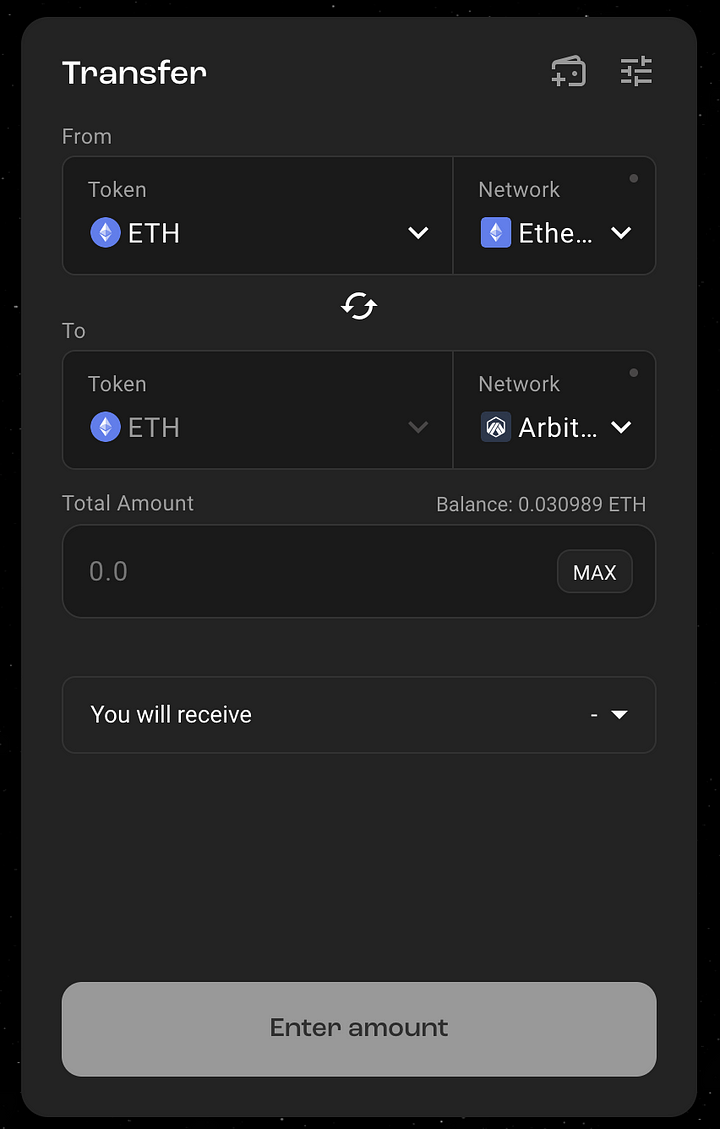
Currently, the available chains to choose from are Ethereum mainnet, BNB Chain, Avalanche, Polygon, Arbitrum, Optimism, Fantom, Metis, Polygon zkEVM, zkSync Era Mainnet, and the recently supported Base network.
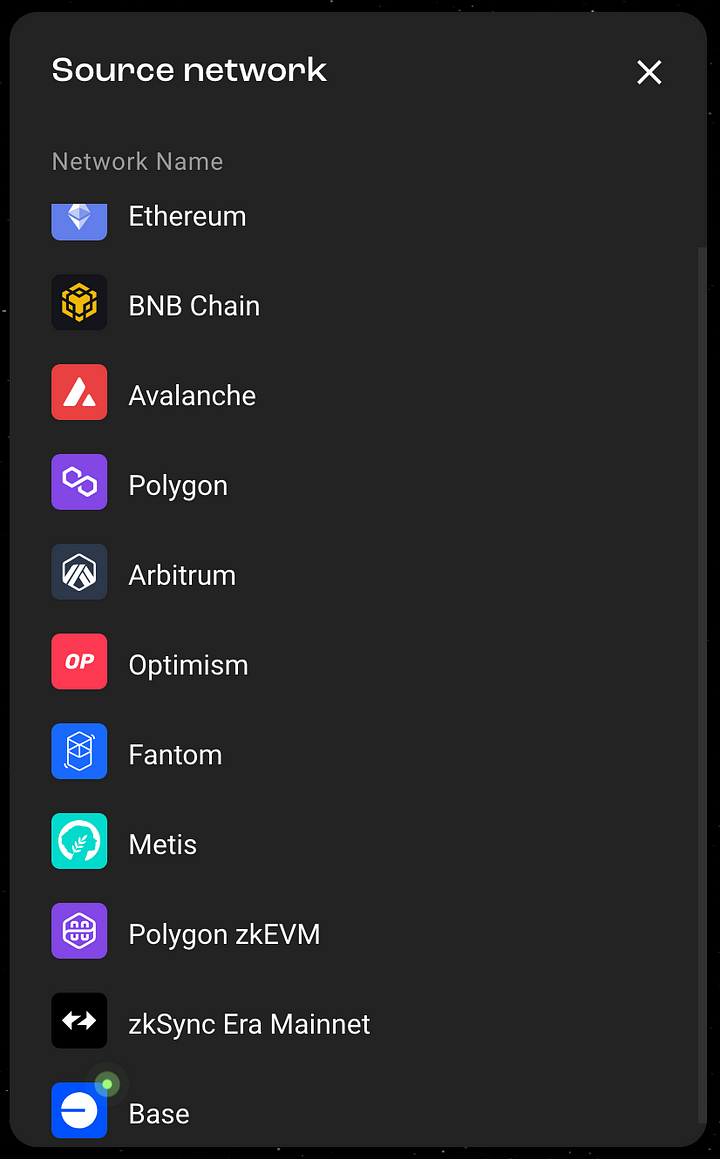 In the Stargate platform, in addition to stablecoins and ETH, it also supports tokens such as CAKE, STG, CRV, and RDNT.
In the Stargate platform, in addition to stablecoins and ETH, it also supports tokens such as CAKE, STG, CRV, and RDNT.
2. Liquidity Provision (Pool)
Liquidity providers can add liquidity to Stargate and receive rewards in every Stargate cross-chain (transfer) transaction.
 Users can choose different liquidity pools to add liquidity. Currently, the main pools are stablecoin pools. After providing liquidity, users will receive LP tokens and receive cross-chain transaction fee rewards from the protocol.
Users can choose different liquidity pools to add liquidity. Currently, the main pools are stablecoin pools. After providing liquidity, users will receive LP tokens and receive cross-chain transaction fee rewards from the protocol.
3. Liquidity Mining (Farming)
Liquidity providers of Stargate can stake their LP tokens to earn STG rewards.
After users obtain LP tokens by providing liquidity, they can use them for liquidity mining and earn STG rewards. The current APY can be as high as 12% or more, which is considered very good returns for stablecoin mining.
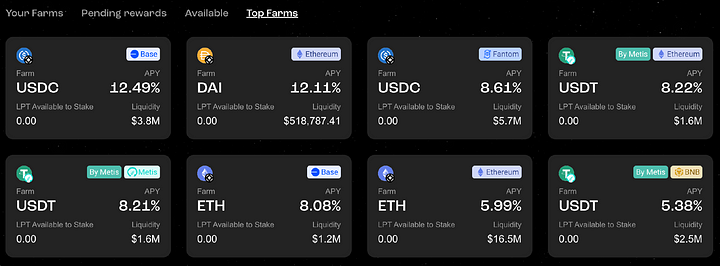
4. STG Staking (Stake)
Users can stake their STG tokens and choose the duration of staking. The longer the staking period, the more veSTG tokens they can earn.
 veSTG will serve as the governance token of the Stargate platform, and holding more tokens will grant more governance weight.
veSTG will serve as the governance token of the Stargate platform, and holding more tokens will grant more governance weight.
Six. Token (STG) Economic Model
The token of the Stargate platform is STG, with a total supply of 1 billion tokens, distributed as follows: 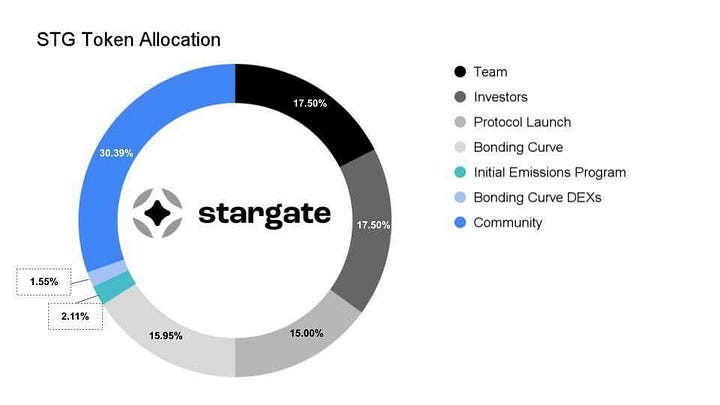
- 17.50% — Stargate Core Contributors (fully locked for 1 year, linear unlocking for the following 2 years);
- 17.50% — Investors (fully locked for 1 year, linear unlocking for the following 2 years);
- 65.00% — Stargate allocated to the community, dedicated to realizing the vision of the protocol: making cross-chain liquidity transfers a seamless single transaction process.
The following are the details of the community allocation:
1) 15.00% — Stargate Protocol Launch;
a. 10.00%: STG launch auction purchase (snapped up by 2 addresses from Alameda).
b. 5.00%: STG-USDC pool on Curve.fi.
2) 15.95% — Joint Curve Auction, post-launch;
3) 2.11% — Initial emission plan;
4) DEX on BNB, Avalanche, Matic, Arbitrum, Optimism, and Fantom will increase by up to 1.55%;
5) The remaining 30.39%: dedicated to future community initiatives and the long-term success of Stargate.
Token release cycle: 
STG tokens can be staked to obtain governance tokens veSTG, and holding veSTG can be used for voting. The longer the staking period, the greater the voting power for stakers.
Seven. Development Status and Competitive Landscape
1. Trading Volume
According to data from defillama, among the current cross-chain bridges, the trading volume in the past 24 hours reached 170 million US dollars, and Stargate’s total chain trading volume reached over 72 million US dollars, accounting for nearly 50% of the cross-chain trading volume, far exceeding the trading volume of other cross-chain protocols. 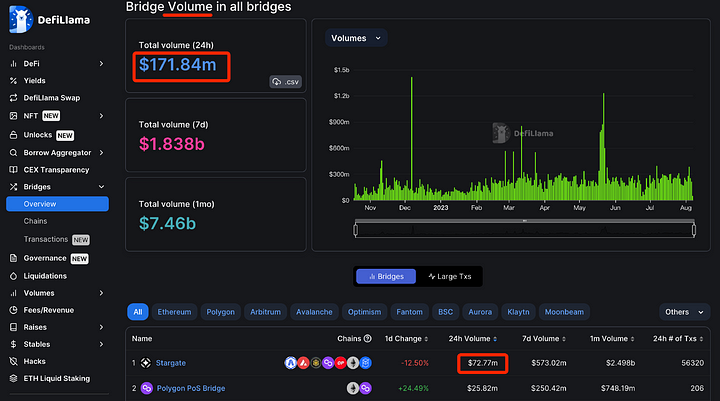
Moreover, among all cross-chain bridges on the Polygon, Arbitrum, Avalanche, Fantom, and BSC chains, Stargate has the highest trading volume, indicating Stargate’s industry position. 
2. TVL
Stargate’s total value locked (TVL) exceeds 300 million US dollars, far higher than other cross-chain bridges such as Hop. 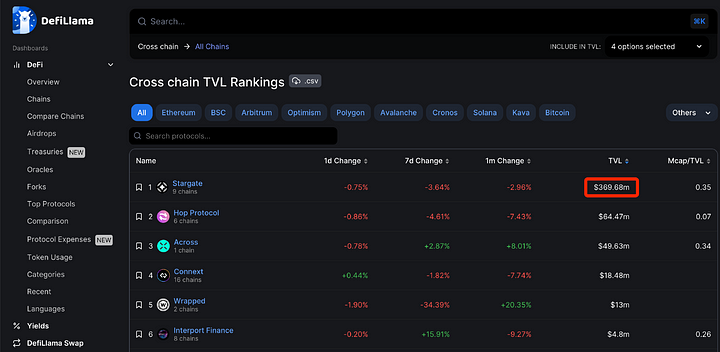
Even among all DeFi protocols, Stargate’s TVL ranks 30th. 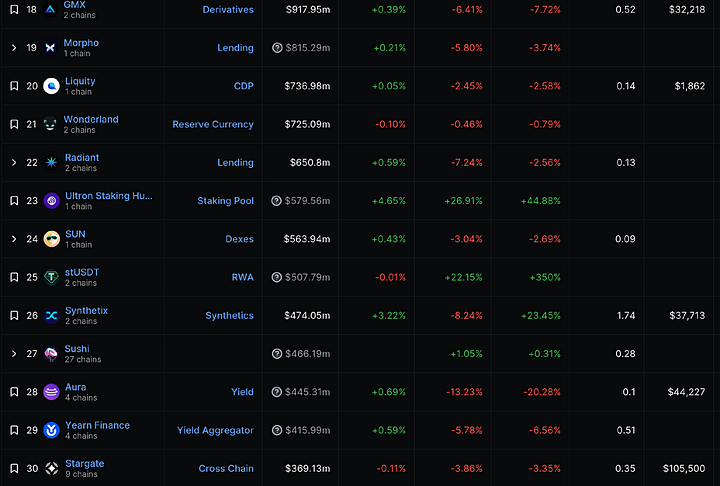
3. Active Users
According to the data from tokenterminal, Stargate has reached a daily active user count of 48,000, which is more than 10 times the daily active user count of other cross-chain bridges. From the trend chart, it can be seen that Stargate’s active users have experienced significant growth since the end of March. 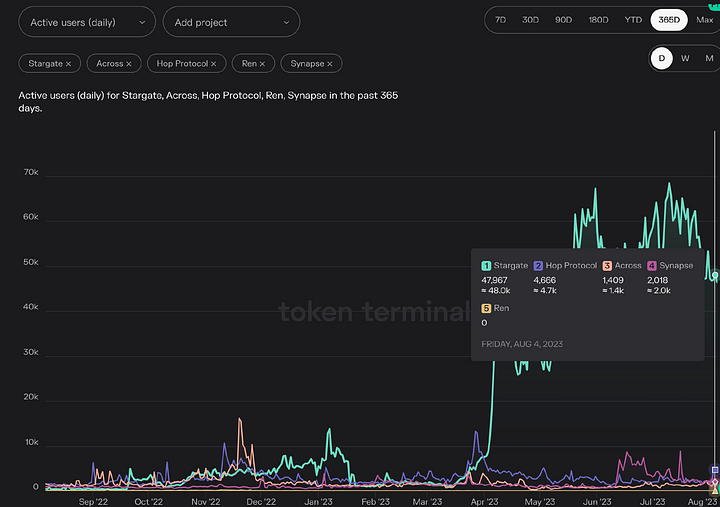
4. Fee
In the past year, the fees generated by Stargate have been continuously increasing. In the past six months, the fee has increased by over 400%, indicating a relatively fast growth rate. 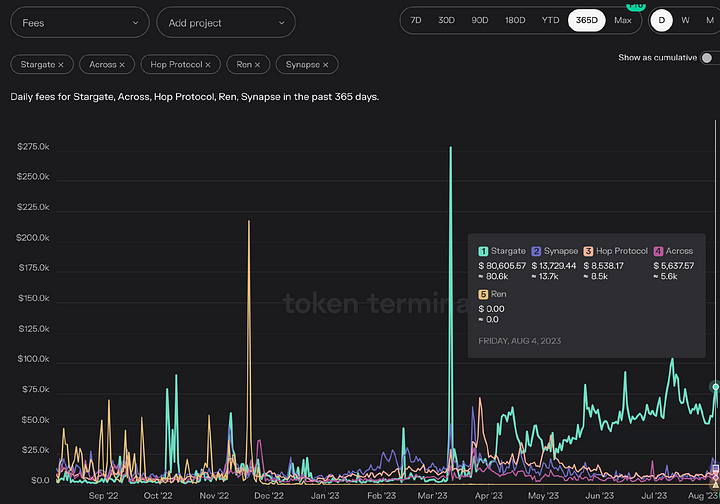
Compared to other cross-chain bridges, Stargate generates over $80,000 in fees per day, which is significantly higher than the fees generated by other cross-chain bridges.
5. Financial Analysis
From Stargate’s financial situation, it can be seen that the earnings have been continuously growing in the past few months, with each month showing a significant increase compared to the previous month. In particular, the earnings in July have exceeded $1 million.
 The transaction volume in the past few months has also been growing. In March, the transaction volume reached over $900 million, while in June, it reached $2.6 billion, nearly three times that of March.
The transaction volume in the past few months has also been growing. In March, the transaction volume reached over $900 million, while in June, it reached $2.6 billion, nearly three times that of March. 
The number of active users each month is also continuously growing. 
From Stargate’s financial data, it can be concluded that the active users, transaction volume, and earnings are all continuously growing. These data to some extent indicate that Stargate is experiencing rapid development.
8. Future Potential
The native token of the Stargate platform is STG, which functions similar to Curve. Users can lock their tokens to obtain veSTG for voting, and the weight of veSTG is allocated based on the lock-up time.
The platform mainly profits from transaction fees. Each non-STG token transfer incurs a platform fee of 0.06%.
In addition to the 0.06% fee for non-STG token cross-chain transfers, there may also be fees for pool rebalancing, which depend on the imbalance of weights between the source chain and the target chain in the pool.
From the previous analysis, it can be seen that Stargate’s performance indicators are all continuously growing.
Furthermore, Stargate is a cross-chain bridge officially launched by LayerZero, which provides great support and promotion for Stargate’s development. For example, it can bring a large number of users to Stargate. Stargate is a standout in the field of multi-chain cross-chain protocols.
The future will undoubtedly be an era of multi-chain coexistence, with more blockchain networks in different forms emerging. With a valuation of $3 billion, LayerZero, as a full-chain interoperability protocol, will connect assets on different chains.
As LayerZero supports more and more chains, Stargate will also support more chains and enable more token cross-chain transactions. This will continuously increase Stargate’s transaction volume, user base, and TVL, driving the development of Stargate.
In addition, as a direct descendant of LayerZero, Stargate’s role is more than just a cross-chain bridge. From Stargate’s documentation, it can be seen that Stargate aims to be a technology provider for asset cross-chain transactions, allowing more projects to easily utilize Stargate and achieve cross-chain functionality.
Therefore, in addition to 2C (consumer-to-consumer) business, Stargate also has 2B (business-to-business) business. In fact, the 2B business model has even more room for imagination than 2C. Based on Stargate, more complex DApps can be built.
Currently, the market capitalization of STG is only slightly over $100 million, ranking 173rd. STG still has considerable room for growth in the future. The Hot Air Balloon will continue to monitor the latest developments of Stargate and share them with everyone in a timely manner.
Like what you're reading? Subscribe to our top stories.
We will continue to update Gambling Chain; if you have any questions or suggestions, please contact us!